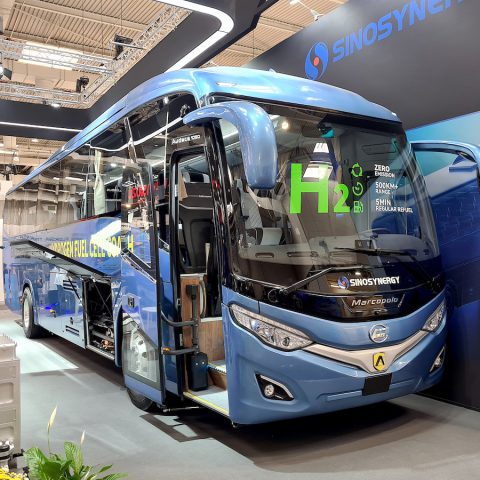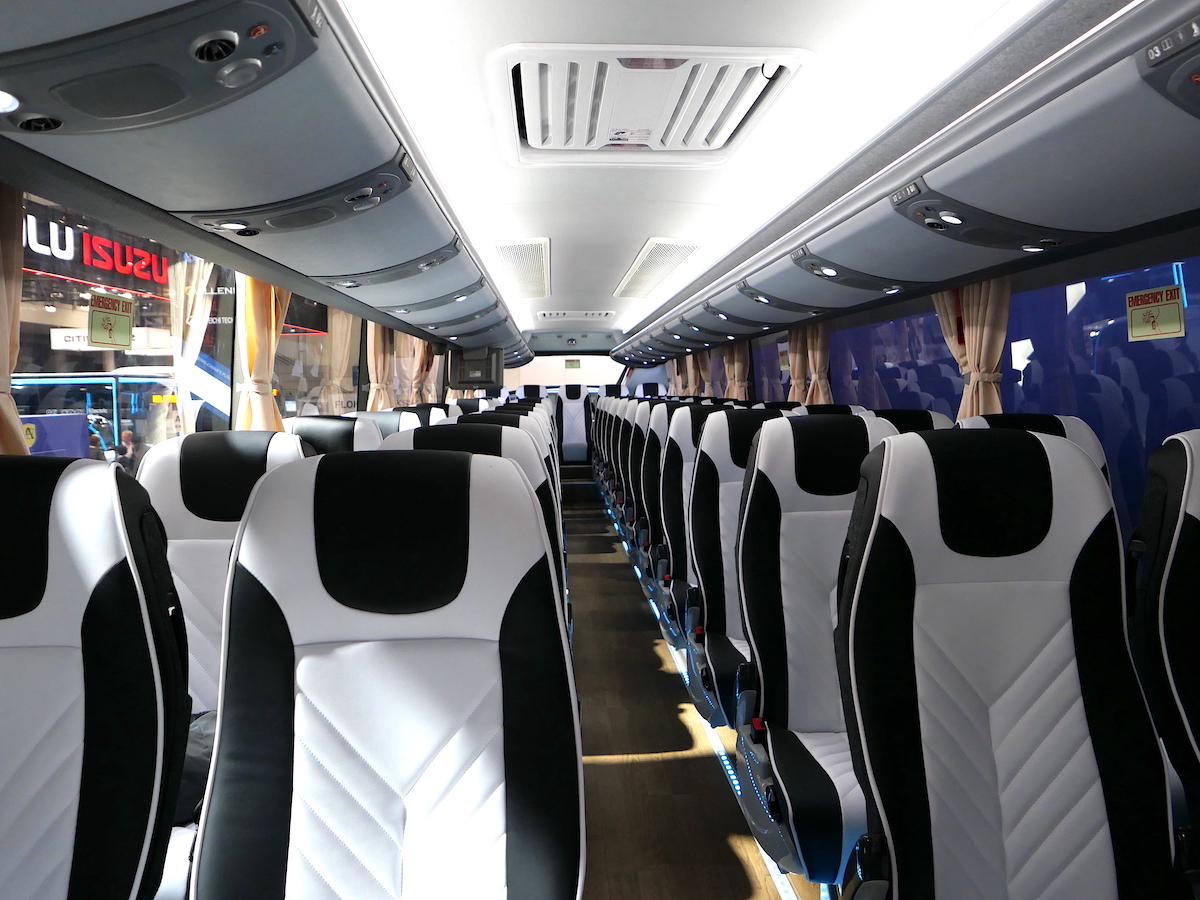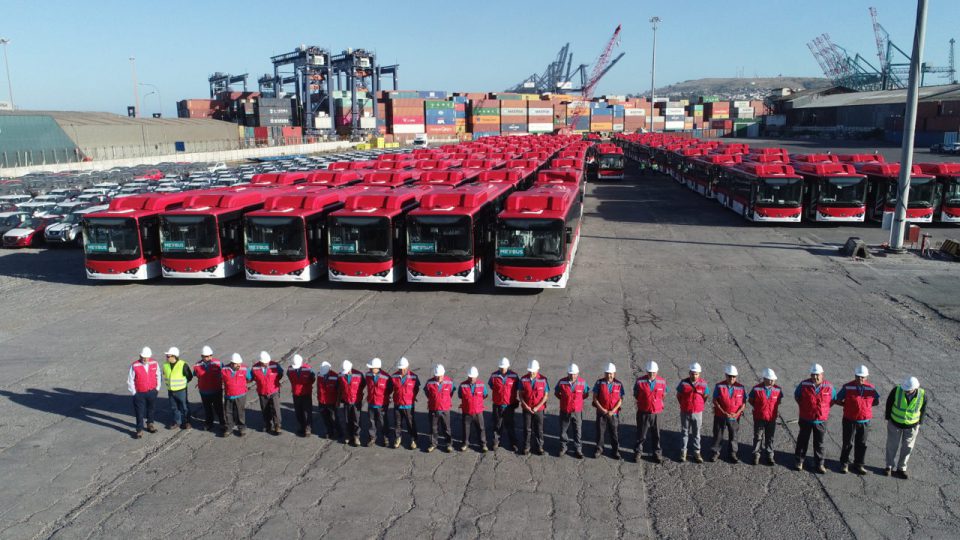The “first fuel cell coach for European market” (from China, by Sinosynergy and Marcopolo)
by omnibus.news / Rüdiger Schreiber Eyes open, at the IAA Transportation in Hall 23 there is a coach that relies on a fuel cell and hydrogen for propulsion. Sino-Synergy Hydrogen Technology Co., Ltd. (Sinosynergy for short) from China is emphasizing at the trade fair in Hanover that the vehicle is the first FCEV coach in […]

by omnibus.news / Rüdiger Schreiber
Eyes open, at the IAA Transportation in Hall 23 there is a coach that relies on a fuel cell and hydrogen for propulsion. Sino-Synergy Hydrogen Technology Co., Ltd. (Sinosynergy for short) from China is emphasizing at the trade fair in Hanover that the vehicle is the first FCEV coach in Europe.
The fact that the premiere is not even noticeable at first glance is due to Marcopolo, the leading bus manufacturer in South America. With plants all over the world, the Brazilians also produce their coaches in the Middle Kingdom – except for the chassis and engines.
Sinosynergy and Marcopolo for the first fuel cell coach for Europe
Instead of a conventional chassis from well-known suppliers such as MAN, Scania or Volvo, this time no internal combustion engine including chassis has been used as the basis. The coach, which Sinosynergy in Hanover keeps referring to as the “Hydrogen Fuel Cell Journey Coach,” is being produced together with Marcopolo on the basis of the Audace 1050 model, which is being built in China.

Sinosynergy is supplying the fuel cell technology, including membranes and fuel cell propulsion, and Feichi Bus in cooperation with Allenbus (both Chinese bus manufacturers and with FCEV vehicles on the market) is supplying the chassis of the bus. Danfoss contributed the drive motor (synchronous permanent magnet), battery storage, and energy conversion technology.
Because the market for FCEV vehicles in Europe is growing strongly and gaining in importance as a result of political considerations, the “Hydrogen Fuel Cell Journey Coach” was also developed in a series specifically for the European market in accordance with EU standards and homologated here.
Technical features of the FCEV coach unveiled at IAA
What’s under the sheet metal? Sustainable Bus / omnibus.news had the technical details explained by Sinosynergy in an interview. The Marcopolo Audace with a length of 12m (also available are 11.9m, 12.3m or 12.6m) drives forward with a wheelbase of 6,100 to 6,650 mm as well as a width of 2.5m and height of 3.7m.

The propulsion engine has a rated power of 143 kW (peak 235 kW) and a rated torque of 495 Nm (peak 720 Nm). The Sinosynergy fuel cell (type G80-001) is supplemented with four CATL LiFeO storage batteries (lithium-iron type). Four hydrogen tanks (currently designed for 700 bar) in the luggage compartment of the bus hold the hydrogen.
For the front axle, the Chinese are using a ZF model (type RL82EC), the driven rear axle is also by ZF /type AV133). The automatic transmission (type THP90) also comes from ZF. The air suspension and the braking technology with EBS, ESP, AEB, LDWS are from Knorr.
Sinosynergy coach: up to 53 passengers on board
Together with local partners, Sinosynergy is now planning to offer the coach not only on the European market but also on the Southeast Asian and American markets. Up to 53 passengers can travel in the bus, and the passenger compartment can be individually equipped according to customer requirements.
And the price? Here the present representatives of Sinosynergy held back at first, only with mentioned comparison prices to FCEV line buses of European offerers was hesitantly said that the basic price at present (the series and thus mass production did not get yet) is under 500,000 euro, one would call exact prices only in dependence of the concrete vehicle equipment the buyer.

Sinosynergy quotes a range of up to 600 km, with refueling taking five minutes. Alternatively to the FCEV drive also a battery-electric solution is in the offer, as it was called on the part of Sinosynergy in Hannover. Sustainable Bus / omnibus.news also asked about this, and here the answer: “The Marcopolo Audace as BEV is to be offered with so-called power batteries (12 packs, again from CATL) with 423 kWh and with a guaranteed range of up to 400 kilometers under urban conditions”. The Chinese did not provide exact details on “urban conditions”; a Standardized on Road Test (SORT) had not been conducted.

Cynthia Zhu, general manager of Sinosynergy, said, “As a pioneer in FCEV propulsion concepts, we are committed to advancing hydrogen technology worldwide. Our entry into the European market at the IAA is an important milestone for us and comes after 5,000 powertrains in vehicles have held their own in everyday use.”
When asked, Sinosynergy says that vehicles equipped with its fuel cells have traveled more than 200 million kilometers to date and are in use in more than 40 cities worldwide. The Chinese company promises a lifespan of up to 30,000 hours when used in commercial vehicles.









